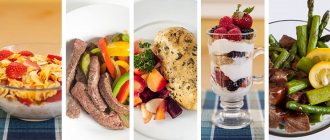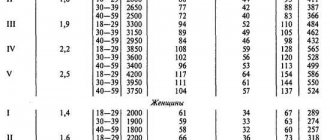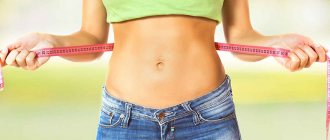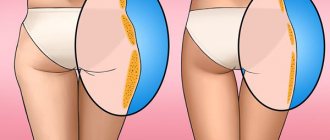Fractional meals for weight loss are the champion among myths in accelerating metabolism. Key ideas: 6-8 meals a day speeds up metabolism; Skipping even one meal will slow down your metabolic rate and you will store fat. In general, to speed up your metabolism you need to eat little, but often.
This idea is repeated endlessly; entire books are devoted to it. Those especially obsessed with losing weight go to extremes. They eat strictly on the clock at regular intervals, even if they have to leave their workplace to eat their perfectly balanced set of foods in a secluded place. For the same reason, they miss meetings with friends, trips to visit, parties, restaurants and other social events.
Acceleration of metabolism
All metabolic processes in the body proceed faster 2-3 hours after eating. From this the conclusion was drawn: in order for the metabolism to be constantly increased, you need to eat methodically by the hour - up to six or even eight times a day.
Metabolism actually increases after eating. Energy is spent on digesting and assimilating food. This is called the thermic effect of food. On average, these processes take up to 10% of all calories received per day (). But the increase in metabolic rate is directly proportional to the number of calories consumed .
If you eat 1,500 calories during the day, your body will spend 150 calories digesting everything you eat. If we eat six times a day, then each meal will be 250 calories. Ten percent of them are 25 calories. But if we multiply this figure by 6 meals, the total for the day still comes out to 150 calories.
It doesn't matter whether you eat three, six or eight times a day. If you get the same calories in both cases, the body will spend the same calories on digestion.
The number of meals does not affect the acceleration of metabolism.
General rules
A balanced diet and physical activity are the basis of health and weight maintenance.
What diet allows you to effectively lose excess weight? The most acceptable and feasible diet is 5 meals a day: two snacks and three main meals. This is the standard regimen recommended by most nutritionists and doctors. The principle of frequent meals in five approaches ensures a comfortable state and is used for weight loss. Why are multiple meals effective? Firstly, with this eating regimen, there is no feeling of hunger, since the production of the hunger hormone ghrelin and overeating is impossible. On the other hand, with a constant feeling of hunger, the body switches to energy conservation and stress accumulation of nutrients for future use, so weight loss is inhibited. If you don’t feel hungry, you can easily control your appetite and the amount of food you eat, resulting in fewer calories per day.
Secondly, such nutrition during a diet is easily tolerated, failures and withdrawal from the diet are excluded. Another positive point is that frequent meals “accelerate” metabolism . After eating, there is an increase in food thermogenesis - the body spends energy on processing and digesting the food eaten. At the same time, the metabolic rate also accelerates. Therefore, with frequent meals, metabolic processes are constantly maintained and more active.
When composing your diet, you need to take into account that the energy consumption for digesting protein foods and vegetables is greater than for digesting carbohydrates. Therefore, simple carbohydrates that have a high calorie content, subject to minimal energy expenditure, are easily stored by the body as fat. Digesting fresh vegetables and fruits also requires more calories than thermally processed ones.
In addition, eating in small portions is physiological: the gastrointestinal tract is not overloaded and the necessary substances are better absorbed. However, you should not eat very often as it takes 2.5 hours for the food to be digested.
By splitting your meals and eliminating simple carbohydrates, you can ensure glucose control and prevent sharp jumps in its level in the blood and, accordingly, the production of insulin in response. This will ultimately help prevent the formation of fat reserves. It is important not only to eat every 3 hours, but also to monitor what you eat and how much you eat in a day.
Frequent meals will be effective in terms of weight loss if you strictly control portions and composition of foods. The serving size depends on the caloric content of the dishes. If it is a vegetable salad, it may be more than a portion of porridge. Use small containers and do not eat extra portions.
Most people skip breakfast, snack on high-calorie rolls, sandwiches and cookies during working hours, and at dinner allow themselves to eat for the whole day. In two weeks you can change the rhythm of eating, but it is better to time this to coincide with your vacation, so that you have time to think through and create a new diet, buy groceries and get used to the new style of eating.
It is better to use an online calculator to calculate your daily calorie intake. Until you develop a stable diet, at first you need to write down the calorie content of foods and dishes, and also keep a food diary.
Following simple nutritional rules will help you lose weight by 0.5 kg per week.
- Constant hours of eating, avoiding hunger, with a break of 3 hours. In terms of time, depending on your work activity, it may look like this: first breakfast 7.00-8.00, second breakfast - 10.00-11.00, lunch - 13.00-14.00, afternoon snack 16.00-17.00, dinner 19.00-20.00.
- Gradually reduce portions and caloric content of food so as not to expose the body to stress. You need to start by eliminating fried, smoked and fatty foods, sugar, confectionery, jam and any baked goods. Consume the most high-calorie foods before lunch, and in the evening - vegetable salads, stewed vegetables, fermented milk products, fish or meat.
- The predominance of low-calorie foods in the diet: vegetables, fish, dietary meats, low-fat dairy products and fruits. During the period of weight loss, calorie content can be 1200-1500 kcal (for women), which depends on physical activity.
- The optimal ratio of proteins, carbohydrates and fats in the diet.
- The mandatory presence of fiber in the diet in the form of vegetables, berries, and fruits.
- Inclusion of slow carbohydrates: porridge, cereal bread, muesli without sugar. You can eat them for breakfast. Healthy carbohydrates should be used for a snack - dried fruits, nuts, in the end, you can eat a piece of dark chocolate with yogurt.
- A protein product (choice of cottage cheese, kefir, fish, yogurt, egg, meat) can be present at every meal. Protein creates a feeling of fullness and a lot of energy is spent on its digestion.
- Meat and fish dishes are prepared by boiling, steaming or baking and served with a vegetable side dish, excluding potatoes and cauliflower.
- Including liquid (purified water) up to 1.5-2 liters per day.
Weight loss will occur gradually, but comfortably, without feelings of hunger, irritation or poor health. In addition, the volume of the stomach will decrease.
Important addition
Sometimes important details are hidden in the little things, failure to comply with which can reduce the entire result to zero.
Here are a few nuances that are simple and should not be forgotten:
- In the morning on an empty stomach you should drink a glass of water.
- You shouldn't skip breakfast, because... After sleep, the body must receive food to activate metabolism.
- You should not skip the other basic techniques, so as not to slow down your metabolism.
- You should avoid using oil in cooking as oil is a source of large amounts of calories. To improve the taste, you can add spices, but in small quantities.
- During your first snack, the food should be light to speed up your metabolism.
Authorized Products
Five meals a day for weight loss may include:
- Vegetables with limitation or exclusion of starchy ones: zucchini, squash, pumpkin, Jerusalem artichoke, potatoes, boiled beets and carrots, cauliflower. You can eat white cabbage, cucumbers, tomatoes, lettuce, bell peppers. To increase the amount of fiber, sesame and flax seeds are added to salads and other dishes.
- Low-fat and fatty (once or twice a week) fish, seafood. When preparing them, do not use fats and do not cook them by boiling or baking.
- Lean meats (beef, rabbit, chicken, turkey) prepared in the same way.
- Vegetable soups cooked in water.
- Unpolished whole grain cereals - buckwheat, whole oatmeal, pearl barley, brown rice. Porridge is cooked in water/milk and without sugar. When losing weight, pasta and potatoes are excluded or consumed very rarely.
- Legumes can be eaten 2-3 times a week - they are excellent sources of fiber and vegetable protein, and they also have a low glycemic index .
- Grain bread, rye, with bran.
- Unrefined vegetable oils are sources of polyunsaturated fatty acids. You can use flaxseed, olive, sesame, and corn oil as a dressing for vegetables.
- Quail and chicken eggs, as an independent dish and as part of vegetable salads.
- Low-fat dairy products, low-fat cheeses (limit to 30-50 g per day).
- Any nuts and seeds (not roasted) in moderation - for snacks and as an addition to salads.
- Herbal teas, green tea with lemon, ginger, ginger tea, rosehip infusion, water, vegetable and fruit juices (the latter are limited due to the high fructose content).
Table of permitted products
| Proteins, g | Fats, g | Carbohydrates, g | Calories, kcal | |
Vegetables and greens | ||||
| greenery | 2,6 | 0,4 | 5,2 | 36 |
| eggplant | 1,2 | 0,1 | 4,5 | 24 |
| beans | 6,0 | 0,1 | 8,5 | 57 |
| zucchini | 0,6 | 0,3 | 4,6 | 24 |
| cabbage | 1,8 | 0,1 | 4,7 | 27 |
| broccoli | 3,0 | 0,4 | 5,2 | 28 |
| boiled cauliflower | 1,8 | 0,3 | 4,0 | 29 |
| bulb onions | 1,4 | 0,0 | 10,4 | 41 |
| carrot | 1,3 | 0,1 | 6,9 | 32 |
| cucumbers | 0,8 | 0,1 | 2,8 | 15 |
| salad pepper | 1,3 | 0,0 | 5,3 | 27 |
| salad | 1,2 | 0,3 | 1,3 | 12 |
| beet | 1,5 | 0,1 | 8,8 | 40 |
| celery | 0,9 | 0,1 | 2,1 | 12 |
| soybeans | 34,9 | 17,3 | 17,3 | 381 |
| asparagus | 1,9 | 0,1 | 3,1 | 20 |
| tomatoes | 0,6 | 0,2 | 4,2 | 20 |
| Jerusalem artichoke | 2,1 | 0,1 | 12,8 | 61 |
| pumpkin | 1,3 | 0,3 | 7,7 | 28 |
| beans | 7,8 | 0,5 | 21,5 | 123 |
| garlic | 6,5 | 0,5 | 29,9 | 143 |
| lentils | 24,0 | 1,5 | 42,7 | 284 |
Fruits | ||||
| avocado | 2,0 | 20,0 | 7,4 | 208 |
| oranges | 0,9 | 0,2 | 8,1 | 36 |
| pomegranate | 0,9 | 0,0 | 13,9 | 52 |
| grapefruit | 0,7 | 0,2 | 6,5 | 29 |
| pears | 0,4 | 0,3 | 10,9 | 42 |
| kiwi | 1,0 | 0,6 | 10,3 | 48 |
| lemons | 0,9 | 0,1 | 3,0 | 16 |
| mango | 0,5 | 0,3 | 11,5 | 67 |
| tangerines | 0,8 | 0,2 | 7,5 | 33 |
| nectarine | 0,9 | 0,2 | 11,8 | 48 |
| peaches | 0,9 | 0,1 | 11,3 | 46 |
| apples | 0,4 | 0,4 | 9,8 | 47 |
Berries | ||||
| gooseberry | 0,7 | 0,2 | 12,0 | 43 |
| Red currants | 0,6 | 0,2 | 7,7 | 43 |
| black currant | 1,0 | 0,4 | 7,3 | 44 |
Nuts and dried fruits | ||||
| nuts | 15,0 | 40,0 | 20,0 | 500 |
| cashew | 25,7 | 54,1 | 13,2 | 643 |
| sesame | 19,4 | 48,7 | 12,2 | 565 |
| flax seeds | 18,3 | 42,2 | 28,9 | 534 |
| fenugreek seeds | 23,0 | 6,4 | 58,3 | 323 |
| sunflower seeds | 20,7 | 52,9 | 3,4 | 578 |
Cereals and porridges | ||||
| buckwheat (kernel) | 12,6 | 3,3 | 62,1 | 313 |
| oat groats | 12,3 | 6,1 | 59,5 | 342 |
| cereals | 11,9 | 7,2 | 69,3 | 366 |
| millet cereal | 11,5 | 3,3 | 69,3 | 348 |
Raw materials and seasonings | ||||
| honey | 0,8 | 0,0 | 81,5 | 329 |
Dairy | ||||
| skim milk | 2,0 | 0,1 | 4,8 | 31 |
| natural yogurt 2% | 4,3 | 2,0 | 6,2 | 60 |
Cheeses and cottage cheese | ||||
| cottage cheese 0.6% (low fat) | 18,0 | 0,6 | 1,8 | 88 |
| curd tofu | 8,1 | 4,2 | 0,6 | 73 |
Meat products | ||||
| beef | 18,9 | 19,4 | 0,0 | 187 |
| rabbit | 21,0 | 8,0 | 0,0 | 156 |
Bird | ||||
| chicken fillet | 23,1 | 1,2 | 0,0 | 110 |
| turkey | 19,2 | 0,7 | 0,0 | 84 |
Fish and seafood | ||||
| fish | 18,5 | 4,9 | 0,0 | 136 |
| squid | 21,2 | 2,8 | 2,0 | 122 |
| mussels | 9,1 | 1,5 | 0,0 | 50 |
| seaweed | 0,8 | 5,1 | 0,0 | 49 |
Oils and fats | ||||
| butter | 0,5 | 82,5 | 0,8 | 748 |
| linseed oil | 0,0 | 99,8 | 0,0 | 898 |
| olive oil | 0,0 | 99,8 | 0,0 | 898 |
| sunflower oil | 0,0 | 99,9 | 0,0 | 899 |
Non-alcoholic drinks | ||||
| mineral water | 0,0 | 0,0 | 0,0 | — |
| green tea | 0,0 | 0,0 | 0,0 | — |
| * data is per 100 g of product | ||||
Fully or partially limited products
- packaged juices;
- fatty meats;
- animal fats;
- sauces;
- sugar;
- fast food and semi-finished products;
- fried foods;
- smoked meats, canned food, sausages;
- fatty dairy products;
- white rice, semolina, pasta;
- baked goods, dough products, cakes, chocolate, pastries, ice cream, condensed milk;
- limit salt.
Table of prohibited products
| Proteins, g | Fats, g | Carbohydrates, g | Calories, kcal | |
Vegetables and greens | ||||
| radish | 1,2 | 0,1 | 3,4 | 19 |
| white radish | 1,4 | 0,0 | 4,1 | 21 |
| red radish | 1,2 | 0,1 | 3,4 | 20 |
| black radish | 1,9 | 0,2 | 6,7 | 35 |
| spinach | 2,9 | 0,3 | 2,0 | 22 |
| sorrel | 1,5 | 0,3 | 2,9 | 19 |
Fruits | ||||
| bananas | 1,5 | 0,2 | 21,8 | 95 |
Berries | ||||
| grape | 0,6 | 0,2 | 16,8 | 65 |
Mushrooms | ||||
| mushrooms | 3,5 | 2,0 | 2,5 | 30 |
Nuts and dried fruits | ||||
| raisin | 2,9 | 0,6 | 66,0 | 264 |
Cereals and porridges | ||||
| semolina | 10,3 | 1,0 | 73,3 | 328 |
| white rice | 6,7 | 0,7 | 78,9 | 344 |
Flour and pasta | ||||
| pasta | 10,4 | 1,1 | 69,7 | 337 |
Confectionery | ||||
| jam | 0,3 | 0,2 | 63,0 | 263 |
| jam | 0,3 | 0,1 | 56,0 | 238 |
| candies | 4,3 | 19,8 | 67,5 | 453 |
| pastry cream | 0,2 | 26,0 | 16,5 | 300 |
| cookie | 7,5 | 11,8 | 74,9 | 417 |
Ice cream | ||||
| ice cream | 3,7 | 6,9 | 22,1 | 189 |
Cakes | ||||
| cake | 4,4 | 23,4 | 45,2 | 407 |
Chocolate | ||||
| chocolate | 5,4 | 35,3 | 56,5 | 544 |
Raw materials and seasonings | ||||
| mustard | 5,7 | 6,4 | 22,0 | 162 |
| mayonnaise | 2,4 | 67,0 | 3,9 | 627 |
Dairy | ||||
| milk 3.6% | 2,8 | 3,6 | 4,7 | 62 |
| milk 4.5% | 3,1 | 4,5 | 4,7 | 72 |
| cream | 2,8 | 20,0 | 3,7 | 205 |
| sour cream 25% (classic) | 2,6 | 25,0 | 2,5 | 248 |
Cheeses and cottage cheese | ||||
| cheese | 24,1 | 29,5 | 0,3 | 363 |
| cottage cheese 11% | 16,0 | 11,0 | 1,0 | 170 |
| cottage cheese 18% (fat) | 14,0 | 18,0 | 2,8 | 232 |
Meat products | ||||
| pork | 16,0 | 21,6 | 0,0 | 259 |
| pork liver | 18,8 | 3,6 | 0,0 | 108 |
| pork kidneys | 13,0 | 3,1 | 0,0 | 80 |
| pork fat | 1,4 | 92,8 | 0,0 | 841 |
| salo | 2,4 | 89,0 | 0,0 | 797 |
| beef liver | 17,4 | 3,1 | 0,0 | 98 |
| beef kidneys | 12,5 | 1,8 | 0,0 | 66 |
| beef brains | 9,5 | 9,5 | 0,0 | 124 |
Sausages | ||||
| smoked sausage | 16,2 | 44,6 | 0,0 | 466 |
| smoked sausage | 9,9 | 63,2 | 0,3 | 608 |
| sausages | 10,1 | 31,6 | 1,9 | 332 |
| sausages | 12,3 | 25,3 | 0,0 | 277 |
Bird | ||||
| smoked chicken | 27,5 | 8,2 | 0,0 | 184 |
| duck | 16,5 | 61,2 | 0,0 | 346 |
| smoked duck | 19,0 | 28,4 | 0,0 | 337 |
| goose | 16,1 | 33,3 | 0,0 | 364 |
Fish and seafood | ||||
| smoked fish | 26,8 | 9,9 | 0,0 | 196 |
| salted fish | 19,2 | 2,0 | 0,0 | 190 |
| Red caviar | 32,0 | 15,0 | 0,0 | 263 |
| black caviar | 28,0 | 9,7 | 0,0 | 203 |
| canned fish | 17,5 | 2,0 | 0,0 | 88 |
| cod (liver in oil) | 4,2 | 65,7 | 1,2 | 613 |
Oils and fats | ||||
| animal fat | 0,0 | 99,7 | 0,0 | 897 |
| cooking fat | 0,0 | 99,7 | 0,0 | 897 |
Non-alcoholic drinks | ||||
| instant coffee dry | 15,0 | 3,5 | 0,0 | 94 |
| black tea | 20,0 | 5,1 | 6,9 | 152 |
| * data is per 100 g of product | ||||
Menu of five meals a day for weight loss (Meal mode)
The weekly menu is based on the principles of healthy eating and takes into account the calorie content of foods. When creating a menu, try to ensure that the 5 meals a day are varied throughout the week. Food should be enjoyable, so don’t rush to eliminate all your favorite foods and dishes at first. Do this gradually, including more vegetables and fruits, whole grain cereals, lean meats and fish, nuts, dried fruits and vegetable oils.
Breakfast can be hearty, since there is a work day ahead, physical activity and increased energy consumption. You can eat porridge (without sugar), vegetable salad, omelet, boiled eggs, tea or juice.
Lunch can also consist of two courses: the first is vegetable soup, the second is boiled meat, or only meat and vegetables. If you want to lose weight, save a light meal for the evening. Usually this is a protein dish and vegetables (meat, fish, chicken with vegetables).
If you prefer fermented milk dishes, then cottage cheese with yogurt or cottage cheese casserole are suitable. Carbohydrate foods should not be consumed in the evening. The less caloric the dinner, the more likely it is that the body will spend more calories digesting food than it receives.
For second breakfast, go for an afternoon snack; depending on the severity of hunger, you can eat an omelet, cottage cheese with yogurt, or just an apple, berries, orange, and drink a glass of juice. Forever eliminate buns, cookies, waffles, halva and sweets as snacks, drink tea and coffee without sugar, and you will notice that your weight gradually decreases.
| Breakfast 8.00 |
|
| Second breakfast 11.00 |
|
| Lunch 13.00 |
|
| Afternoon tea 16.00 |
|
| Dinner 19.00 |
|
| Breakfast 8.00 |
|
| Second breakfast 11.00 |
|
| Lunch 13.00 |
|
| Afternoon tea 16.00 |
|
| Dinner 19.00 |
|
| Breakfast 8.00 |
|
| Second breakfast 11.00 |
|
| Lunch 13.00 |
|
| Afternoon tea 16.00 |
|
| Dinner 19.00 |
|
| Breakfast 8.00 |
|
| Second breakfast 11.00 |
|
| Lunch 13.00 |
|
| Afternoon tea 16.00 |
|
| Dinner 19.00 |
|
| Breakfast 8.00 |
|
| Second breakfast 11.00 |
|
| Lunch 13.00 |
|
| Afternoon tea 16.00 |
|
| Dinner 19.00 |
|
| Breakfast 8.00 |
|
| Second breakfast 11.00 |
|
| Lunch 13.00 |
|
| Afternoon tea 16.00 |
|
| Dinner 19.00 |
|
| Breakfast 8.00 |
|
| Second breakfast 11.00 |
|
| Lunch 13.00 |
|
| Afternoon tea 16.00 |
|
| Dinner 19.00 |
|
Peculiarities
The main principles of the fractional power system:
- Eat 5-6 times a day.
- Make portions small - 250 g, maximum 300 g. If you measure without scales, then the portion should be the size of your palm.
- You need to eat by the hour - always at the same time.
- Minimize the amount of salt and sugar, and completely eliminate junk food.
- When creating a menu, take into account the correct ratio of proteins, fats and carbohydrates - you should not allow a skew in one direction.
For breakfast , you are allowed to eat the most high-calorie foods. It is best to give preference to carbohydrates. The ideal option is grain milk porridge with fruit. Breakfast should be hearty. Its share of daily calorie content is 25%. For the second snack, only 5%. Nuts, berries, and vegetables are also allowed.
Hot dishes are recommended for lunch The specific weight of calorie content is 35% of the daily value. For an afternoon snack, fermented milk products, fresh juices, cocktails, and smoothies are suitable. This meal also takes up only 5% of the daily calorie intake.
for dinner , and these are mainly protein foods and foods high in fiber. Steamed meat or fish is best, and stewed or boiled vegetables as a side dish. Dinner takes up approximately 25% of daily calories. An hour before going to bed, it is recommended to drink kefir or herbal decoction. The share of daily caloric intake is 5%.
If you follow these rules, split meals will help you get rid of extra pounds. This system is also used to treat various diseases of the digestive tract. Why does weight loss happen:
- The body gets used to a constant supply of food, so fat reserves do not appear, because food is better digested.
- There is no overeating.
- Portions are always limited.
- All foods in the diet are beneficial for the body.
Advantages and disadvantages
| pros | Minuses |
|
|
Diet options
To understand how to lose weight on fractional meals, it is important to decide on the type of diet. Organizing multiple meals serves as a tool that is used in various approaches:
- protein-carbohydrate alternation (PCA) – changing the ratio of macroelements according to the chosen scheme;
- paleo diet - organization of the diet according to the principle of nutrition of ancient man;
- keto diet - predominance of fats in the menu;
- low-carbohydrate diet – allows you to lose excess fat by reducing carbohydrates in your diet;
- The Dukan diet consists of four stages, each of which has a specific goal.
Reviews and results
This food is suitable for those who find it difficult to tolerate strict diets accompanied by a constant feeling of hunger. With fractional meals, this is impossible, and overeating is also excluded. Losing weight occurs slowly and if you stick to such a diet constantly, then the lost weight will not return. According to reviews, weight loss results are different for everyone. On average, weight loss is 4.5-5 kg per month, which depends on the individual menu, physical activity and portion size.
- “... I ate 5 times a day and that was enough to prevent hunger. I made a diet for 1400-1500 kcal. Snacks consisted of apples, oranges, pears, grapefruit, and if you really wanted to eat, then a portion of cottage cheese with kefir. On such a diet (it can be called proper nutrition) there will be no quick weight loss, and I knew it. I joined the gym and lost 7 kilograms in six months. I tried to expand my diet and gained 1.5 kg in a month, but I really leaned on sweets and baked goods, which I missed.”
- “... The main thing for losing weight is proper nutrition and exercise. I liked that I didn’t have to starve or go on a strict diet. I didn’t lose much weight (only 3.5 kg in a month), but I didn’t restrict myself too much. My portions were 250 ml for soups, 3 spoons of cereals, a bowl of salads and 150 g of meat, fish or cottage cheese. If I wanted to eat, I increased the portion. Now I eat like this all the time: vegetable soup, chicken, boiled meat or fish, stewed vegetables, 2 slices of black bread, 3-4 loaves of bread, fruit, cottage cheese and an omelet. I alternate them throughout the day and have already gotten used to this diet. If you increase the load or reduce the portions, you can lose more weight.”
You should like fractional meals
An attitude towards a positive result is of great importance for losing weight. It is very important to get enough sleep, as a poorly rested person in a bad mood will try to “eat up” his mood and “fall off” the diet.
For a man losing weight, it is of great importance whether his family supports him in his quest to lose weight. In those families where the man feels moral support, the results appear faster. It also matters how the small portions are prepared and what they are placed in.
To create an optimistic mood and ease of filling and carrying to work, the dishes should be comfortable, practical, and close well. Plastic containers with tightly closing lids are suitable for this to avoid opening and leaking on the way to work.










